
(a)
Find the coefficient of restitution between A and B
(a)
Answer to Problem 13.178P
The coefficient of restitution between A and B
Explanation of Solution
Given information:
The weight of the block A
The weight of the block B
The weight of the block C
The coefficient of friction between the block and plane
The initial speed of the block A
The blocks B and C are at rest.
The distance between the blocks (d) is
The width of the each blocks (b) is
The acceleration due to gravity (g) is
Calculation:
Calculate the mass of the block A
Substitute
Calculate the mass of the block B
Substitute
Calculate the mass of the block C
Substitute
Show the diagram of the block A just before its impact with block B as in Figure (1).
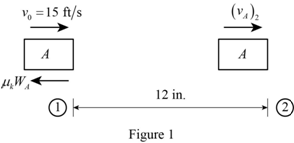
The expression for the initial kinetic energy of the block A at position ‘1’
Here,
The expression for the kinetic energy of the block A at position ‘2’ just before its impact with blocks B
Here,
The expression for the work done by the block A to overcome frictional force
The expression for the principle of work and energy to the block A at position ‘1’ and position ‘2’ just before its impact with block B as follows:
Substitute
Substitute
Show the diagram of the block A just after its impact with block B as in Figure (2).
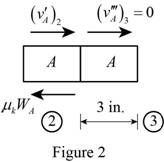
The expression for the kinetic energy of the block A immediately after the impact
Here,
The block finally comes to stop after the impact. Thus,
The expression for the work done by the block A after the collision to overcome the frictional force
The expression for the principle of work and energy to the block A after it collides with block B to find the velocity of the block A after its impact with B as follows:
Substitute
Substitute
Show the momentum impact diagram of the blocks A and B as in Figure (3).
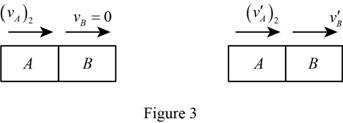
The expression for the principle of conservation of momentum to the collision between the block A and block B as follows:
Here,
Substitute
Calculate the coefficient of restitution for the impact between the block A and block B
Substitute 0 for
Therefore, the coefficient of restitution between A and B
(b)
Find the displacement (x) of block C.
(b)
Answer to Problem 13.178P
The displacement (x) of block C is
Explanation of Solution
Given information:
The weight of the block A
The weight of the block B
The weight of the block C
The coefficient of friction between the block and plane
The initial speed of the block A
The blocks B and C are at rest.
The distance between the blocks (d) is
The width of the each blocks (b) is
The acceleration due to gravity (g) is
Calculation:
Show the diagram of the block B just before its impact with block C as in Figure (4).
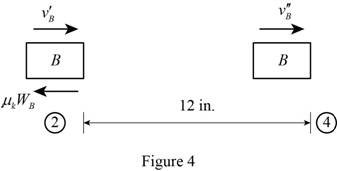
The expression for the kinetic energy of the block B at position ‘2’ just after the impact with block A
The expression for the kinetic energy of the block B just before its impact with blocks C at the position ‘4’
Here,
The expression for the work done by the block B to overcome the frictional force in reaching position ‘4’ from position ‘2’ as follows:
The expression for the principle of work and energy to the block B just before its impact with block C at the position ‘2’ and position ‘4’ as follows:
Substitute
Substitute
Show the momentum impact diagram of the blocks B and C as in Figure (5).
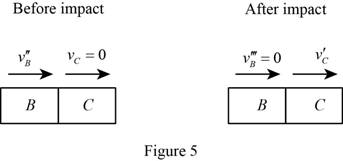
The expression for the principle of conservation of momentum to the collision between the block B and block C as follows:
Substitute
Here,
Substitute
Calculate the coefficient of restitution for the impact between the block B and block C
Substitute 0 for
Show the diagram of the block C after its impact with Block B as in Figure (6).

The expression for the kinetic energy of the block C immediately after its impact with blocks B at position ‘4’
Finally, at the position ‘5’, the block C comes to rest. Thus,
The expression for the work done by the block C to overcome the frictional force in reaching the position ‘5’
Here, x is the distance travelled by the block C before coming to rest.
The expression for the principle of work and energy to the block C after its impact with block B as follows:
Substitute
Substitute
Therefore, displacement (x) of block C is
Want to see more full solutions like this?
Chapter 13 Solutions
Vector Mechanics for Engineers: Statics and Dynamics
- Block 1 with a weight of 60 lb hits block 2 (W = 20 Ib) at a velocity of 9 ft/s. The two blocks then stick after the impact and move together until they stop. The coefficient of kinetic friction is 0.26. Determine the time it takes for the blocks to stop. Note: Block 2 is initially at rest. V1 V 1 1 Before impact After impact The time it takes for the blocks to come to rest is sec.arrow_forwardA small 5-kg sphere moves at a constant speed along the horizontal circular path. Note that ACB is a single wire passing through a ring at C attached to the sphere. Calculate the speed of the sphere, when 0₁ = 50°, d= 0.8 m, the radius of the circular path is 1.6207 m, and the tension in both portions of the wire is 43 N. Present your answer in m/sec using 3 significant figures. B Ꮎ 01arrow_forwardA crate has a mass of 120kg and the coefficient of static and kinetic friction is 0.60 and 0.50, respectively. The crate starts from rest and the motor exerts a tension T= 1220 + 200t (N). If the elevation of the dock is 30 degrees from the horizontal, a. What is the velocity of the crate after 1sec? b. Compute the power transmitted after 1sec.arrow_forward
- The coefficient of kinetic friction between the50-kg crate and the ground is HE 0.3. The crate starts from rest, and P = 205 N. Part A Determine the velocity of the crate when t= 3s Express your answer to three significant figures and include the appropriate units. ANSWER Part B Determine the distance the crate travels when 3 s. Express your answer to three significant figures and include the appropriate units. ANSWER: s =arrow_forwardQ21. The 10-lb block A attains a velocity of 7 ft/s in 5 seconds, starting from rest. Block Bhas a weight of 9 lb. Determine the coefficient of kinetic friction between block A and the horizontal plane. Neglect the weight and friction of the pulley. Please pay attention: the numbers may change since they are randomized. Your answer must include 3 places after the decimal point. Take g = 32.2 ft/s². A Your Answer: Answer Barrow_forwardThe overworked Amazon delivery person is driving up a steep hill with an incline of 26° when a box they forgot to secure starts sliding toward the back of the truck. The 3.5 kg box starts from rest near the drivers seat and slides 2.1 m along the floor to the rear door. The coefficient of kinetic friction between the box and the floor is 0.36. What is the work done by the weight of the box? Wmg What is the work done by the Normal Force? WN What is the work done by the frictional force? Wf = = = J What is the net work done on the box? Wnet = What the change in kinetic energy for the box? AKE = How fast is the box moving just before it hits the rear door? Vfinal = Sarrow_forward
- Part A The 190-kg crate rests on the ground for which the coefficients of static and kinetic friction are u, = 0.5 and u = 0.4, respectively. The winch delivers a horizontal towing force T to its cable at A which Determine the speed of the crate when t = 3.9 s. Hint: First determine the force needed to begin moving the crate. varies as shown in the graph. Originally the tension in the cable is zero. (Figure 1) Express your answer to three significant figures and include the appropriate units. v = Value Units Submit Request Answer Figure Provide Feedback T (N) 800 T- 400 2 (s)arrow_forwardBullet B has a mass of 50 g and blocks A and C both have a mass of 0.9 kg. The coefficient of friction between the blocks and the plane is uk= 0.33. Initially the bullet is moving at vo and blocks A and C are at rest (Figure 1). After the bullet passes through A, it becomes embedded in block Cand all three objects come to stop in the positions shown (Figure 2). Determine the (a) velocity of block A after the impact, (b) velocity of block C after the impact, (c) initial speed of the bullet vo. В Vo A 0.3 m - (1) 0.26 m A (2) m/s. The velocity of block A after the impact is The velocity of block C after the impact is The initial speed of the bullet is m/s. m/s.arrow_forwardThe 152 kg block shown starts with a velocity of 3.00 m/s downward from position A and slides down the incline plane to position B. The coefficient of friction between the block and the plane is u = 0.15. What is the velocity of the block at position B? Note: answer to be in meters/second (m/s). 20 m 152 kg H = 0.15 12 A Barrow_forward
- Determine the initial acceleration (positive if to the right, negative if to the left) of the 13-kg block if (a) T = 17 N and (b) T = 20 N. The system is initially at rest with no slack in the cable, and the mass and friction of the pulleys are negligible. 13 kg 29 Ha=0.431 Hk= 0.31 m/s² m/s² Answers: (a) a = (b) a = i iarrow_forwardA flat-bed truck weighing 7200 lb carries a 1500 lb box. As the truck starts from rest with a constant acceleration, the box slides 10 feet to the edge of the bed in the time that it takes the truck to acquire a velocity of 25 mph in a distance of 50 feet up the incline. Determine the coefficient of friction between the box and the truck bed. acx= 10.74 ft/s2 N = 1498 lb ay = 0 ft/s2. arx 13.44 ft/s2 f=575 lb 100 5 ac/x-2.697 ft/s2 Mk=0.384arrow_forwardBlock A has a mass of 10 kg and bloc B has a mass of 2 Kg and are kept at rest. The 2 blocs are comected by a cord passing by a wheel at the top of the incline. The surface of the incline has a friction coefficient -0.12. The angle of the incline is 0= 30°. A is at 6 meters above the incline floor. After being released from rest, the bloc A will move down. Determine the total energy of the bloc A after it has moved down the incline by 4 meters.. Calculate its velocity. 6 m Barrow_forward
 Elements Of ElectromagneticsMechanical EngineeringISBN:9780190698614Author:Sadiku, Matthew N. O.Publisher:Oxford University Press
Elements Of ElectromagneticsMechanical EngineeringISBN:9780190698614Author:Sadiku, Matthew N. O.Publisher:Oxford University Press Mechanics of Materials (10th Edition)Mechanical EngineeringISBN:9780134319650Author:Russell C. HibbelerPublisher:PEARSON
Mechanics of Materials (10th Edition)Mechanical EngineeringISBN:9780134319650Author:Russell C. HibbelerPublisher:PEARSON Thermodynamics: An Engineering ApproachMechanical EngineeringISBN:9781259822674Author:Yunus A. Cengel Dr., Michael A. BolesPublisher:McGraw-Hill Education
Thermodynamics: An Engineering ApproachMechanical EngineeringISBN:9781259822674Author:Yunus A. Cengel Dr., Michael A. BolesPublisher:McGraw-Hill Education Control Systems EngineeringMechanical EngineeringISBN:9781118170519Author:Norman S. NisePublisher:WILEY
Control Systems EngineeringMechanical EngineeringISBN:9781118170519Author:Norman S. NisePublisher:WILEY Mechanics of Materials (MindTap Course List)Mechanical EngineeringISBN:9781337093347Author:Barry J. Goodno, James M. GerePublisher:Cengage Learning
Mechanics of Materials (MindTap Course List)Mechanical EngineeringISBN:9781337093347Author:Barry J. Goodno, James M. GerePublisher:Cengage Learning Engineering Mechanics: StaticsMechanical EngineeringISBN:9781118807330Author:James L. Meriam, L. G. Kraige, J. N. BoltonPublisher:WILEY
Engineering Mechanics: StaticsMechanical EngineeringISBN:9781118807330Author:James L. Meriam, L. G. Kraige, J. N. BoltonPublisher:WILEY





